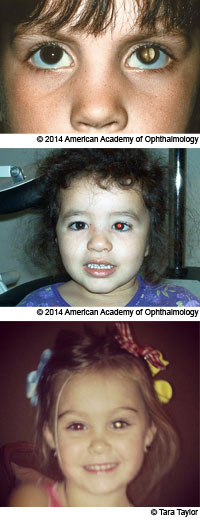Did you know that a photo could provide valuable and life-saving information about the health of a child's eyes?
When Tara Taylor posted a photograph of her 3-year-old daughter on Facebook, friends told her that the glow in the girl's eye could indicate something wrong. As a result, Rylee Taylor was diagnosed with a rare eye disease that can cause vision loss. But thanks to early detection, ophthalmologists were able to save her sight.
More than ever, we are taking and sharing pictures with a growing audience of people on social media. Paying close attention to photos of children can reveal both common and rare eye problems. We can see them in the reflection of the camera flash off the retina, also known as the red reflex.
What Do Red Eyes in Photos Mean?
A red reflex happens when the flash of a camera lights up the blood-rich retina. If the eyes are looking directly at the camera lens and the color of the reflex in both eyes is red, that's usually a good sign that the retinas of both eyes are unobstructed and healthy.
When a Camera Flash Turns Eyes White, Yellow or Black in Photos
 An abnormal red reflex is a white, yellow or black reflection in one or both eyes. This can be a warning sign for the presence of an eye condition. A pediatric ophthalmologist can diagnose these conditions.
An abnormal red reflex is a white, yellow or black reflection in one or both eyes. This can be a warning sign for the presence of an eye condition. A pediatric ophthalmologist can diagnose these conditions.
Dr. Jane Edmond, MD, Baylor College of Medicine and Texas Children's Hospital, points out that it's important to note whether a photo has been taken under optimal conditions to present a true abnormal red reflex. Be sure that:
- the child looks directly at the camera lens
- the camera flash is on
- the background is dimly lit, and
- red-eye reduction is off
If you do spot an abnormal red reflex, bring the photo to your child's pediatrician or a pediatric ophthalmologist.
Very often, a white reflex may not actually signal anything abnormal. "Instead, the child is probably looking off to the right of the camera, and the white reflection occurs in the left eye because the optic nerve is lined up perfectly with the camera and the flash."
"Overwhelmingly, the most common cause of an abnormal red reflex is refractive error," said Dr. Michael Repka, MD, Johns Hopkins Hospital. A refractive error means that your eye doesn't refract the light properly, so the image you see is blurred. Myopia (nearsightedness), hyperopia (farsightedness) and astigmatism are types of refractive error.
"Most of the time, this is a problem fixed with glasses," Dr. Repka said.
An Abnormal Red Eye Reflex in Photos Can Help Diagnose Serious Eye Conditions
On rare occasions, abnormal red reflexes can signal more dangerous eye conditions.
Asymmetrical red eye in camera flash
An asymmetrical red reflex is when:
- only one eye reflex appears red, or
- one eye's red reflex is dimmer than the other
This may be an sign of strabismus. Strabismus is a misalignment of the eyes, when both eyes do not look at the same place at the same time.
Treatment may include:
- eyeglasses,
- prisms,
- patching or blurring the strong eye, or
- eye muscle surgery.
It is important to detect and treat strabismus early. An ophthalmologist can often correct strabismus with excellent results.
White eye in camera flash
A white reflex (called leukocoria) that covers most of the pupil can be a red flag. It can indicate several serious eye disorders including:
- cataracts,
- retinal detachments, and
- infections inside the eye.
It can also be a warning sign of retinoblastoma, an extremely rare and very serious childhood cancer of the eye. When caught and treated early, retinoblastoma is curable 95 percent of the time.
Yellow eye in camera flash
A yellow reflex can be a sign of Coats' disease. This is when blood vessels inside the eye that provide blood and oxygen to the retina become twisted and leaky. These leaky vessels create a blockage in the retina that can cause vision loss or retinal detachment. It occurs mostly in boys under age 10, and usually affects only one eye. Treatment can include laser surgery, cryotherapy or, in later stages of the disease, more invasive surgery.
Coats' disease can be difficult to distinguish from a retinoblastoma through photographs. This is because the white and yellow reflexes look similar, Dr. Edmond said.
The Red Eye Effect Makes a Picture Worth a Thousand Words
Pediatricians should check for red reflex at every wellness visit using an ophthalmoscope. Even the most serious eye conditions don't typically cause children pain or visual impairment in early stages. In most cases, one of the child's eyes is working normally, so complaints are rare — even when something is wrong.
"A young child isn't going to tell you 'By the way, when I cover one of my eyes I can't see.' They just go on with life," Dr. Repka said.
Research is underway to develop software that can automatically detect leukocoria and other abnormal red reflexes in photographs. Meanwhile, screening and sharing pictures, both online and printed, may lead to early detection that could save vision or a life.